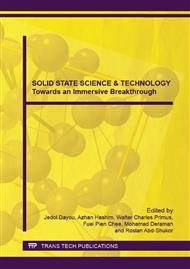[1]
T. H. Kim, W. Wang. & Q. Li. Advancement in materials for energy-saving lighting devices. Front. Chemical Engineering Science. 6(1) (2012) 13-26.
Google Scholar
[2]
B-T. Chen, Y-H. Tai, Y-J. Kuo, C-C. Tsai. & H-C. Cheng. New pixel circuits for driving active matrix organic light emitting diodes. Solid-State Electronics 50(2) (2006) 272–275.
DOI: 10.1016/j.sse.2005.12.016
Google Scholar
[3]
C. Alkan, Y. Tek. & D. Kahraman. Preparation and characterization of a series of thiourea derivatives as phase change materials for thermal energy storage. Turkish Journal of Chemistry. 35(5) (2011) 769-777.
DOI: 10.3906/kim-1008-3
Google Scholar
[4]
H. K. Adli, W. M. Khairul and H. Salleh. Synthesis, Characterization and Electrochemical Properties of Single Layer Thin Film of N-Octaxyphenyl-N'-(4-Chlorobenzoyl)Thiourea-Chlorophyll as Potential Organic Photovoltaic Cells. International Journal of Electrochemical Science. 7 (2012).
DOI: 10.1016/s1452-3981(23)13354-2
Google Scholar
[5]
R. Rahamathullah, W. M. Khairul, H. Salleh, H. K. Adli, M. I. N. Isa and M. G. Tay. Synthesis, Characterization and Electrochemical Analysis of V-Shaped Disubstituted Thiourea-Chlorophyll Thin Film as Active Layer in Organic Solar Cells. International Journal of Electrochemical Science. 8 (2013).
DOI: 10.1016/s1452-3981(23)14394-x
Google Scholar
[6]
W. M. Khairul, M. F. Yusof, R. Rahamathullah, A. I. Daud, S. M. Jasman, M. F. A. Hasan, H. Salleh, H. K. Adli and M. G. Tay. Single Molecule Thin Film Featuring Disubstituted Thiourea (TU) Doped with Chlorophyll as Potential Active Layer in Photovoltaic Cell. International Journal of Electrochemical Science. 8 (2013).
DOI: 10.1016/s1452-3981(23)12877-x
Google Scholar
[7]
R. H. Jusoh, W. M. Khairul, M. S. M. Yusof, M. A. Kadir and B. M. Yamin. Structural and spectroscopic studies of novel methylbenzoylthiourea derivatives. The Malaysian Journal of Analytical Sciences. 1(15) (2011) 70-80.
Google Scholar
[8]
C. M. Ozer, H. Arslam, D. VanDerveer. & N. Kulcu. Synthesis and characterization of N-(Arylcarbamothioyl)-cyclohexanecarboxamide Derivatives: The Crystal Structure of N-(Naphthalen-1-ylcarbamothioyl)cyclohexanecarboxamid. Molecules 14(2) (2009).
DOI: 10.3390/molecules14020655
Google Scholar
[9]
S. R. Ghazali, W. M. Khairul. & M. Shamsuddin. Synthesis and Characterisation of Palladium (II) Complex of (N-Pentanoylthioreido)-N'-Propanoic Acid and Its Application as Catalyst in Heck Cross Coupling Reaction. Australian Journal of Basic and Applied Sciences. 7(9) (2013).
Google Scholar
[10]
J. Pathak, V. Narayan, L. Sinha. & O. Prasad. Theoretical Raman and FTIR vibrational analysis of 2-phenyl-1H-indene-1, 3(2H)-dione by ab initio method. Journal of Atomic and Molecular Sciences 3 (2012) 95-105.
DOI: 10.4208/jams.051111.063011a
Google Scholar
[11]
O. Estevez-Hernandez, E. Otazo-Sanchez, J. L. Hidalgo-Hidalgo de Cisneros, E. Reguera. A Raman and infrared study of 1-furoyl-3-monosubstituted and 3, 3-disubstituted thioureas. Spectrochimica Acta Part A. 62(4-5) (2005) 964-971.
DOI: 10.1016/j.saa.2005.04.016
Google Scholar
[12]
S. M. Jasman, W. M. Khairul. & M. Shamsudin. Spectroscopic and Thermal Studies of Palladium (II) Complex of N-(5-methylpyridin-2-ylcarbamothiol) Cinnamamide Ligand. Research Journal of Recent Sciences. 2(11) (2013) 12-19.
Google Scholar
[13]
D. L. Pavia, G. M. Lampman. & G. S. Kriz. 2001. Introduction to Spectroscopy. 3rd edition. Thomson Learning Inc.
Google Scholar
[14]
J. Liu, S. Yang, X. Li, H. Fan, P. Bhadury, W. Xu, J. Wu. & Z. Wang. Synthesis and Antiviral Bioactivity of Chiral Thioureas Containing Leucine and Phosphonate Moieties. Molecules. 15(8) (2010) 5112-5123.
DOI: 10.3390/molecules15085112
Google Scholar
[15]
G. Kavak, S. Ozbey, G. Binzet. & N. Kulcu. Synthesis and single crystal structure analysis of tree novel benzoylthiourea derivatives. Turkish Journal of Chemistry. 33 (2009) 857-868.
DOI: 10.3906/kim-0901-1
Google Scholar
[16]
S. Rajeswari, G. V. Prabhu. & V. Ramkumar. Spectroscopic Studies and Crystal Structure of 1-[(2, 5-dioxopyrrolidin-1- yl)(phenyl) methyl] Thiourea. Journal of Chemical Crystallography. 39(9) 2009 650-654.
DOI: 10.1007/s10870-009-9538-8
Google Scholar
[17]
C. Reichaedt. Solvatochromic Dyes as Solvent Polarity Indicators. Chemical Reviews. 94 (1994) 2319-2358.
DOI: 10.1021/cr00032a005
Google Scholar
[18]
M. H. Harun, E. Sainon, A. Kassim, N. Yahya. & E. Mahmud. Conjugated Conducting Polymers: A Brief Overview. JASA 2. (2007) 63-68.
Google Scholar


